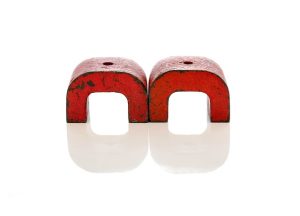
It’s a common misconception that all permanent magnets are either ceramic (ferrite) or rare-earth. While ceramic and rare-earth magnets are certainly common, alnico is a popular alternative. An acronym for aluminum, nickel and cobalt, alnico magnets are used in musical instruments, electronics and lifting devices. Here are the pros and cons of alnico magnets.
Pro: Heat Resistant
Alnico magnets are very heat resistant. They can withstand temperatures of up to 900 degrees Fahrenheit — all while maintaining their magnetic properties. Heat, of course, typically weakens magnets. When exposed to heat, a magnet’s kinetic energy will increase, resulting in the misalignment of its magnetic domain. While alnico magnets aren’t immune to this phenomenon, they are better protected against heat than all other types of magnets.
Pro: Strong Magnetic Field
Alnico magnets produce a notably strong magnetic field. They are stronger than ceramic magnets. With that said, alnico magnets are still weaker than rare-earth magnets, such as neodymium magnets. Nonetheless, the strong and heat-resistant properties of alnico magnets make them a popular alternative to traditional ceramic magnets.
Pro: Durable
Another advantage of alnico magnets is durability. Magnets, particularly ceramic magnets, are somewhat brittle. They can crack or break easily. When a magnet breaks into two or more pieces, each piece will have its own north and south poles, meaning the pieces will function as separate and independent magnets. Alnico magnets, though, are durable and better protected against physical damage than their ceramic counterparts.
Con: Weight
One of the disadvantages of alnico magnets is their weight. They are heavier than most other types of magnets. Why does this matter? Alnico magnets are commonly used in aerospace components where weight is critically important. Thanks to their lightweight properties, alnico magnets won’t weight down the aircraft with which they are used.
Con: Cost
Alnico magnets are typically more expensive than traditional ceramic magnets. If you’re on a budget, you may want to stick with a ceramic magnet. On the other hand, alnico magnets cost less than rare-earth magnets.
Con: Susceptible to Demagnetization
Another disadvantage of alnico magnets is their susceptibility to demagnetization. They can become demagnetized when exposed to an external magnetic field. If the poles of an alnico magnet and another magnet are placed together in the same direction, the alnico magnet will become weaker.
In Conclusion
Alnico magnets offer several advantages and disadvantages. They are heat resistant, produce a strong magnetic field, and they are durable. Alnico magnets, though, are heavier, cost more than many other magnets, and they are susceptible to demagnetization.
